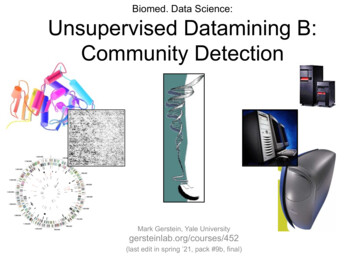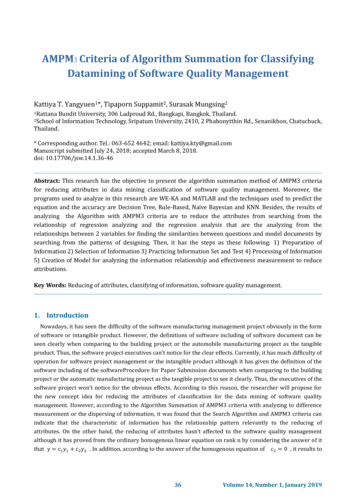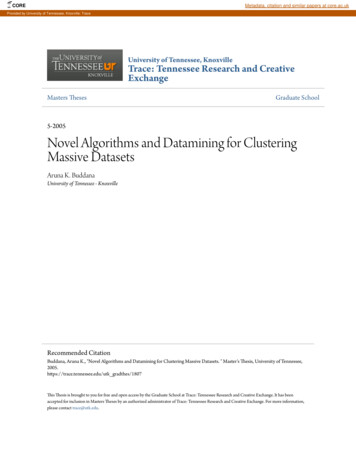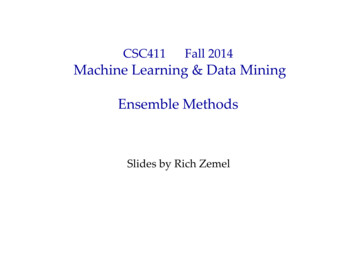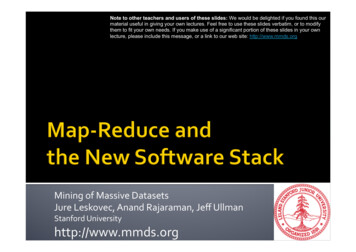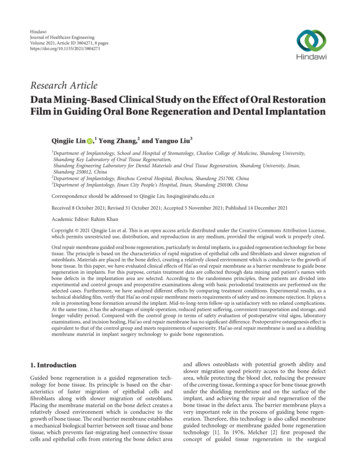
Transcription
HindawiJournal of Healthcare EngineeringVolume 2021, Article ID 3804271, 8 pageshttps://doi.org/10.1155/2021/3804271Research ArticleData Mining-Based Clinical Study on the Effect of Oral RestorationFilm in Guiding Oral Bone Regeneration and Dental ImplantationQingjie Lin ,1 Yong Zhang,2 and Yanguo Liu31Department of Implantology, School and Hospital of Stomatology, Cheeloo College of Medicine, Shandong University,Shandong Key Laboratory of Oral Tissue Regeneration,Shandong Engineering Laboratory for Dental Materials and Oral Tissue Regeneration, Shandong University, Jinan,Shandong 250012, China2Department of Implantology, Binzhou Central Hospital, Binzhou, Shandong 251700, China3Department of Implantology, Jinan City People’s Hospital, Jinan, Shandong 250100, ChinaCorrespondence should be addressed to Qingjie Lin; linqingjie@sdu.edu.cnReceived 8 October 2021; Revised 31 October 2021; Accepted 5 November 2021; Published 14 December 2021Academic Editor: Rahim KhanCopyright 2021 Qingjie Lin et al. This is an open access article distributed under the Creative Commons Attribution License,which permits unrestricted use, distribution, and reproduction in any medium, provided the original work is properly cited.Oral repair membrane guided oral bone regeneration, particularly in dental implants, is a guided regeneration technology for bonetissue. The principle is based on the characteristics of rapid migration of epithelial cells and fibroblasts and slower migration ofosteoblasts. Materials are placed in the bone defect, creating a relatively closed environment which is conducive to the growth ofbone tissue. In this paper, we have evaluated clinical effects of Hai’ao oral repair membrane as a barrier membrane to guide boneregeneration in implants. For this purpose, certain treatment data are collected through data mining and patient’s names withbone defects in the implantation area are selected. According to the randomness principles, these patients are divided intoexperimental and control groups and preoperative examinations along with basic periodontal treatments are performed on theselected cases. Furthermore, we have analyzed different effects by comparing treatment conditions. Experimental results, as atechnical shielding film, verify that Hai’ao oral repair membrane meets requirements of safety and no immune rejection. It plays arole in promoting bone formation around the implant. Mid-to-long-term follow-up is satisfactory with no related complications.At the same time, it has the advantages of simple operation, reduced patient suffering, convenient transportation and storage, andlonger validity period. Compared with the control group in terms of safety evaluation of postoperative vital signs, laboratoryexaminations, and incision healing, Hai’ao oral repair membrane has no significant difference. Postoperative osteogenesis effect isequivalent to that of the control group and meets requirements of superiority. Hai’ao oral repair membrane is used as a shieldingmembrane material in implant surgery technology to guide bone regeneration.1. IntroductionGuided bone regeneration is a guided regeneration technology for bone tissue. Its principle is based on the characteristics of faster migration of epithelial cells andfibroblasts along with slower migration of osteoblasts.Placing the membrane material on the bone defect creates arelatively closed environment which is conducive to thegrowth of bone tissue. The oral barrier membrane establishesa mechanical biological barrier between soft tissue and bonetissue, which prevents fast-migrating heel connective tissuecells and epithelial cells from entering the bone defect areaand allows osteoblasts with potential growth ability andslower migration speed priority access to the bone defectarea, while protecting the blood clot, reducing the pressureof the covering tissue, forming a space for bone tissue growthunder the shielding membrane and on the surface of theimplant, and achieving the repair and regeneration of thebone tissue in the defect area. The barrier membrane plays avery important role in the process of guiding bone regeneration. Therefore, this technology is also called membraneguided technology or membrane guided bone regenerationtechnology [1]. In 1976, Melcher [2] first proposed theconcept of guided tissue regeneration in the surgical
2Journal of Healthcare Engineeringtreatment of periodontal disease, using this technology totreat periodontal disease to obtain new periodontal attachment and regeneration of alveolar bone. Nyman et al. [3]and others first used nonabsorbable microporous membranes to treat periodontal disease and also obtained newperiodontal attachment and alveolar bone regeneration.After entering the 1980s, with the widespread use of artificialdental implants, guided bone regeneration techniques havebeen gradually used in implant surgery. In 2015, the firstanimal experiment was conducted to guide bone regeneration using nonabsorbable membrane. The results showedthat the effect of technology in promoting bone regenerationis very significant [4]. After applying this technology clinically, patients were followed up for ten years and it wasfound that all patients have achieved good repair effects [5].Later, other scholars conducted more extensive and in-depthresearch on technology. At the end of the century, thetechnology was first introduced into dental implants toreconstruct the defective bone tissue. The results showed thatthe average bone defect height was reduced by 82%. As thetechnology matures, many scholars at home and abroadhave used it in clinical dental implant surgery.To address this challenging issue, clinical effects ofHai’ao oral repair membrane as a barrier membrane to guidebone regeneration in implants are evaluated in this paper.For this purpose, certain treatment data are collectedthrough data mining and patient’s names with bone defectsin the implantation area are selected. According to therandomness principles, these patients are divided into experimental and control groups and preoperative examinations along with basic periodontal treatments are performedon the selected cases. The major scientific contributions ofthis paper are as follows:(i) To evaluate the effectiveness of the Hai’ao oral repairmembrane, which is usually used as barrier membrane to guide bone regeneration in implants, inoral bone regeneration and dental implantationprocess carried out in hospitals.(ii) Selected patients are divided into control and experiment groups using a well-known procedurecalled randomness principles.(iii) To perform extensive and thorough investigation onthe selective cases, which are chosen based on required conditions. Furthermore, how the treatmentprocess is effective on the recovery process of thesegroups and follow-up duration, specifically for thetreatment of patients, for both groups is advised,which is based on experimental data values.(iv) Finally, this article proposes using Hai’ao oral repairmembrane as a shielding membrane material inimplant surgery technology to guide boneregeneration.The remainder of the article is planned according to thegiven guidelines.In the subsequent section, that is, Section 2, a briefliterature review is presented, which is followed by theproposed model’s experimental setup and procedures. InSection 4, experimental results are thoroughly examined,where various results are compared with the existingbenchmark models available for the problem under consideration in this article. Finally, concluding remarks aregiven along with references.1.1. Related Work. Domestic immediate implant researchmainly focuses on the histological study of the effect ofimplant surface microstructure on osseointegration andother basic research and animal experiments on guidedtissue regeneration technology and guided bone regeneration technology. There are fewer clinical trials, small samplesize, and shorter research time, but the success rate is aboutthe same as that of traditional implants. For example,Hoexter [5] chose Camlog implant system, Bio-Gide absorbable collagen membrane, and Bio-Oss artificial bone,and a total of 62 implants were implanted: 36 in the anteriorarea, 18 in the premolar area, and 8 molar implants in thearea with an average follow-up observation of 28 months. Asa result, 2 implants in the posterior region were loosenedwithin 2–4 weeks after surgery. The remaining cases have agood clinical effect. The success rate is 95.2%. It is believedthat the application of the membrane-guided regenerationtechnology in immediate dental implant surgery is reliableand can achieve good clinical results. Fediaev et al. [6] reported that the combined application of Bio-Oss with theabsorbable collagen membrane Bio-Gide can effectivelypromote the quantity and quality of immediate bone tissueregeneration around the implant and can promote the boneimplant bonding rate. In recent years, more and moreimplant doctors at home and abroad have conducted a largenumber of studies on the clinical effects of immediate implantation technology. The results show that immediateimplantation combined with GBR technology can achieve ahigher success rate. Although GBR technology has obtainedsatisfactory clinical results in the application of immediateimplantation, there are still some problems in the application. Soft tissue valve dehiscence, membrane exposure, andinfection are the most common problems in GBR immediateimplantation. While GBR technology limits the growth ofsoft tissues, it also limits the blood supply and protection ofsoft tissues to the wound area. Therefore, after using a barrierfilm, there is often a risk of postoperative wound dehiscence.In the case of wound dehiscence, infection is not onlyguaranteed, but the osteogenesis effect cannot be guaranteed. It is also easy to cause planting failure. The incidence ofsoft tissue valve dehiscence and membrane exposure is related to the type of biofilm used. Because the nondegradablemembrane has the characteristics of high strength and beingnot easy to form, it is more difficult to provide attachmentand retention for the mucoperiosteal flap. Therefore, thedehiscence rate of the soft tissue flap is higher when thenonabsorbable membrane is used than when the absorbablemembrane is used. In particular, the current domestic Qinmembrane, without any pores in its structure, after application, in addition to restricting the entry of fibroblasts intothe defect area, also restricts the entry of blood and evenplasma. De Andrade et al. [7] reported that the wound
Journal of Healthcare Engineeringdehiscence rate of Bio-Gide membrane was 7.1%, while thatof Qin membrane was 21.1%, and the self-healing conditionof Bio-Gide collagen membrane after exposure was betterthan that of those using Qin membrane. In the clinicalresearch of most scholars, membrane exposure infection hasappeared, and the exposure rate is quite high. In 1994, Foteket al. [8] reported 63 cases of implants using membranematerials, 14% had membrane exposure and infection, and14% were exposed to the oral cavity without infection.AlGhamdi and Buhite [9] performed collagen membraneguided tissue regeneration on 30 patients immediately afterimplantation. There was a case of membrane exposure afterimmediate implantation. Liu et al. [10] reported 25 cases ofusing e-PTFE membrane, and 14 cases of varying degrees ofmembrane exposure occurred 10–120 days after surgery.Research by Engelke WG, Diedederichs CG, and so forth[11] also found that those who used guided tissue regeneration surgery had a significantly higher proportion ofmembrane exposure and infection than those who did not.Although there are different reports on the membrane exposure rate, most scholars believe that the membrane exposure rate is 12%–16% [11, 12]. In recent years, there havebeen no reports of membrane exposure in the relevantliterature on the application of frozen allogeneic dura mater,allogeneic periosteum, and autologous drill periosteal flaps.Therefore, how to avoid soft tissue valve dehiscence andmembrane exposure is the key for GBR technology to guidebone regeneration failure. Regarding the reason for theexposure of the membrane, most scholars believe that this isdue to the soft tissue gap in the heel after the tooth extraction. In order to seal the biofilm, the lip and buccal heelflap and the tongue heel flap must be sutured together tomake the heel flap tension easy. Cracking occurs and exposure occurs. Gotfredsen et al. analyzed that the time ofmembrane exposure mostly occurred in 2–4 weeks aftersurgery and therefore believed that the membrane exposurewas caused by the interference of the smooth surface of thebiofilm and hindering the attachment of soft tissue flaps.Some scholars believe that the incidence of soft tissue valvedehiscence is related to the type of biofilm used. Nonabsorbable membranes are difficult to form due to their highstrength and are difficult to provide attachment retention formucoperiosteal flaps. Therefore, soft tissue valve cracks andopening rate are higher than those of the absorbable film.Some scholars have also suggested that e-PTFE membranesand stents containing power-increasing stents are easy topierce the valve and cause the membrane to be exposed whenthe shape is not good. Goldman [13] also proposed exposuredue to poor retention of biofilms. At present, the measurestaken to solve the problems of membrane exposure and softtissue flap infection mainly include the following categories:(1) Reasonable incision design, to ensure that there areenough mucoperiosteal flaps to cover the wound. Ifnecessary, the bone plate on the lips and tongue of thetooth extraction wound should be pressed againstcentral reduction, to reduce soft tissue tension.(2) Using a sealing nut to fix the biofilm on the implantor using Shunkang medical glue to fix the biofilm on3the alveolar bone to prevent membrane displacement[14, 15]. In addition, some scholars believe that it isnot important whether the soft tissue flap is closedor not and whether the membrane is exposed or not.As long as good oral hygiene is ensured, gargle witha special oral gargle and give anti-infective treatment. When the epithelial cells heal for months, thetissue can completely close the wound. However,most scholars agree that once submembrane infection occurs, the membrane must be removedimmediately.2. Proposed Method2.1. Research Objective. With 30 subjects enrolled, agedbetween 18 and 70 years, 16 cases in the test group weretreated with oral repair membranes, 10 males and 6 females,with an average age of 37 years. In the control group, 14 caseswere treated with medical collagen membrane, 12 males and2 females, with an average age of 36.1 years.2.1.1. Case Selection Criteria(1) Subjects are 18–70 years old, and gender is notlimited.(2) Patients with dental implant indications and insufficient bone mass and need to apply technology forbone augmentation.(3) Exclude systemic and local contraindications.2.1.2. Case Exclusion Criteria(1) Cases that do not meet the inclusion criteria.(2) Unstable vital signs.(3) People with severe heart disease, unstable anginapectoris, cardiac insufficiency, and myocardialinfarction.(4) Patients with chronic kidney disease or renalinsufficiency.(5) Patients with clear liver disease or liverinsufficiency.(6) Diabetic patients.(7) Breast-feeding or pregnant women.(8) People with a history of allergies to multiple drugsor patients with recent allergies, having used drugsknown to cause damage to major organs within4 weeks.(9) Patients with mental illness.(10) Specific allergies, especially those who are sensitiveto collagen.2.2. Method of Operation. Thirty patients with bone defectsin the implantation area were selected. According to theprinciple of randomness, they were divided into 16 cases inthe experimental group and 14 cases in the control group.
4Journal of Healthcare Engineering(i) Carry out preoperative examination and basicperiodontal treatment for selected cases.(ii) Carry out implant surgery, implant implants, andmeasure the “labial alveolar bone thickness of theimplant before bone grafting” and the “alveolarbone thickness before bone grafting” using a tendegree Vernier caliper.(iii) Implant bone material as needed. The bone graftmaterial used in the operation is “Tianbo Tegu”bone powder. The bone powder is soaked innormal saline by the surgical assistant according tothe instructions and placed on the labial bonedefect area of the implant to increase the amount ofalveolar bone.(iv) Use a tenth-degree Vernier caliper to measure thethickness of the alveolar bone on the labial side ofthe implant after bone grafting.(v) Choose a suitable oral repair film. According to theshape and size of the wound, trim the “Hai’ao OralRepair Film” and “Bot Medical Collagen Film” tothe appropriate size and place them in the bonegraft area of the test group and the control group.Cover 2-3 mm at the edge. After fully relaxing thesoft tissue flap, 4–0 silk suture was interrupted toclose the wound.(vi) After 5 days of postoperative anti-inflammatorytreatment and 10 days later, follow-up and sutureremoval were done.(vii) A follow-up visit was one month after the operation, and clinical examination and line film wereto observe the condition of the alveolar bone andthe osseointegration of the implant.(viii) Two-stage implant surgery was performed 3months after surgery, the mucosa was reopened,the osseointegration of the implant was observedand the amount of new bone tissue was measuredand evaluated, and the thickness of the alveolarbone on the labial side of the implant was measured, according to clinical standards; evaluateosteogenesis, and calculate osteogenesis thickness.(ix) Calculate the bone growth effect and the averagegrowth effect according to the bone growtheffect osteogenesisthickness/bonegraftthickness 100%.(x) Complete the restoration of implant denture, aswell as clinical inspection of the restoration effect.(xi) Follow up every 6 months and take X-rays toobserve bone resorption.(xii) In order to reduce system errors, all data aremeasured by the same staff under the sameconditions.3. Experimental Results and ObservationsIn this section, we have described how the experimentalsetup was created and how many patients were selected,what their selection criteria are and how the results areobtained, and, finally, how the proposed model is realized inactual environmental setting of the traditional hospital.3.1. Experiment Procedure. Connect frozen physiologicalsaline to the planting machine, turn on the foot switch,connect the planting mobile phone to the planting machine,and finally turn on the power. The test patient rinsed withhydrogen peroxide for a minute before the operation, initially disinfected the oral cavity, and then rinsed with normalsaline. The iodophor solution used by the assistant physiciandisinfects the patient’s implantation area and oral cavity face.The subject’s chair position is suitable. When the uppercollar teeth are planted, the upper collar is approximately 45degrees Celsius with the ground; when the lower collar teethare planted, the lower collar is approximately 30 degreesCelsius with the ground, and the mouthpiece is placed, andsterile towels and surgical drapes are placed. Adopt azurearticaine epinephrine injection to perform local infiltrationanesthesia in the planned implantation area. For somepatients who are sensitive to pain, use painless injectioninstrument for local infiltration anesthesia. The cuttingdesign is fan-shaped, and both sides reach the membranebrewing joint. A round blade is used to cut the mucosa andmucoperiosteal to the bone surface in turn, and use aperiosteal dissector to open the mucoperiosteal flap tocompletely reveal the alveolar bone. According to 31 implantation operation requirements, prepare holes and implant implants in the planned implantation area step by step.Artificial bone material is implanted in the labial bone defectarea as needed. Soak the bone meal with normal saline andplace it on the bone defect area to increase the amount ofalveolar bone. During the operation, the bone graft materialsused in the experimental group and the control group were“Tianbo Tegu” bone powder. Use ten-degree Vernier caliperto measure the thickness of the bone graft. Choose a suitableoral repair film, according to the shape and size of thewound, trim the “Zhenghai Oral Repair Film” and the “BotMedical Collagen Film” to the appropriate size, and placethem in the bone graft area of the test group and the controlgroup. We repaired the edge of the film to cover the defectarea to 2.0-3.0 mm, completely relaxed the teeth and filledthe soft tissue flap, and then sutured the wound with 0–4 mmsilk thread. Put sterile cotton rolls in the intraoral surgeryarea to stop bleeding, take out the sterile cotton rolls after 30minutes, and observe the condition of the serum after theincision. After the operation, oral scalp and metronidazoleanti-inflammatory treatment was given for 5 days, whilegargling with medical mouthwash for 1 week. After 10 days,follow up and remove the stitches, conduct a clinical evaluationof the incision healing, perform a physical examination on thepatient, and record the examination results. After 1, 3, and 6months and every 6 months’ follow-up, clinical examinationand radiographs were performed to observe the condition ofalveolar bone and implant osseointegration. Follow up 3months after surgery, perform physical examination andlaboratory examination, and record the results of the examination. Perform implant secondary surgery, reopen the
Journal of Healthcare Engineeringmembrane, observe the osseointegration of the implant andmeasure and evaluate the amount of new bone tissue,measure the thickness of the labial alveolar bone of theimplant, evaluate the osteogenesis according to clinicalstandards, and calculate the result of bone thickness.According to the bone growth effect osteogenesis thickness/bone graft thickness 100%, calculate the bone growtheffect and the average growth effect.3.2. Record Measurement Data. This test mainly qualitativelystudies the effect of different shielding membrane materialsin guiding bone regeneration. The indicators to be observedand recorded are as follows: During the first-stage operation:before bone graft, alveolar bone thickness D1; before bonegraft, labial alveolar bone thickness D2; after bone graft, thethickness of the labial alveolar bone is D3; the thickness ofthe bone graft is A D3 D2; and during the second stageoperation: the thickness of the alveolar bone is D4.The thickness of osteogenesis D4 D1.3.3. Clinical Evaluation Criteria3.3.1. Effectiveness Evaluation. Main efficacy indicators:bone growth effect (%)(1) Bone growth effect (%) (osteogenesis thickness (B)/bone graft thickness (A)) 100%.(2) Superior effect: bone growth effect 95%.(3) Marked effect: 80% bone growth effect 95%.(4) Invalid: bone growth effect 80%.(5) Superior effect and marked effect are counted aseffective.3.3.2. Secondary Indicators. Incision Healing.3.3.3. Safety Evaluation Criteria. Analyze the relationshipbetween laboratory abnormalities, abnormal signs, andadverse events and applied materials.3.4. Data Management3.4.1. Data Collection(1) The researcher must ensure that the data is true,complete, and accurate.(2) All items in the research record must be filled out.“No blanks or missing items can only be crossedwhen making any corrections.” Note the reviseddata. The initials of the name of the researcher mustbe signed and dated. The original records must notbe erased or overwritten.(3) Laboratory inspection items are complete. After thetrial cases are observed, the research records andother materials will be submitted to the person incharge of clinical trials for review and preservationfor final statistics. Data monitoring: the clinical trial5supervisors review a record sheet for each originalstudy to confirm that the clinical trial data recordsare timely, accurate, standardized, and complete.3.5. Statistical Processing. Record the required data, input allinto the computer, and use the software to analyze the data.Use frequency, median, mean, composition ratio, and soforth to describe quantitative and qualitative data. Before theformal analysis of the quantitative data, the normality test ofthe data distribution is first performed; for the data thatmeets the normal distribution, the two-independent-samplet-test or the paired t-test is used to test the two sets of indicators or the indicators before and after the operation.Data conformed to the normal distribution, using nonparametric test to test the two groups of indicators or indicators before and after the operation. When analyzingqualitative data, use the Pearson chi-square test or the exactprobability method to test. In the effect analysis, noninferiority test is used, and other statistical tests are twosided tests. p less than 0.05 is considered to be statisticallysignificant. Covariance analysis was used to compare thedata between groups to eliminate the possible effects ofbaseline data.4. Results and AnalysisIn this experiment, GBR technology was used to repair thebone defect around the implant, and the effect of differentmembrane materials to guide bone regeneration was analyzed qualitatively and quantitatively.4.1. Qualitative Research Indicators(1)(2)(3)(4)Incision healing.Evaluation of implant osseointegration.Evaluation of the effect of occlusal reconstruction.Safety evaluation.4.2. Quantitative Research Indicators(1) Basic information of the patient.(2) Changes in physical examination and laboratoryexamination data before and after implantation.(3) Comparison of intraoperative bone graft thickness.(4) Comparison of bone formation thickness during thesecond-stage operation.(5) Comparison of bone growth effects.4.3. Clinical Trial Results4.3.1. Qualitative Research Indicators. A total of 30 subjectswere enrolled in this trial: 16 in the experimental group and14 in the control group. The incision healing rates of theexperimental group and the control group were 100%, bothof which were Grade A healing. Implant osseointegration isgood, all repair is completed, and the patient’s occlusal
6Journal of Healthcare Engineeringfunction is restored. In terms of safety, one patient in thecontrol group had an adverse event of swelling in the operation area 3 days after the operation. No adverse event wasfound in the test group during the entire trial.Table 1: Comparison of age composition between test and controlgroups.4.3.2. Quantitative Research Indicators. The age composition, gender composition, various vital signs, and laboratorytest results of the preoperative test group and the controlgroup are similar. The thickness of the unilateral bone graftin the two groups during the operation is the same. The vitalsigns of the postoperative test group and the control groupare the same. The index and the laboratory examinationindex are the same; there is no significant difference in theeffect of the two components of the bone. Adverse eventsand side effects found in clinical trials and their treatmentare as follows: one patient in the control group developedfacial swelling. After symptomatic treatment, the swellingdisappeared.Number of casesAverage llagenStatisticsvaluemembrane14——37.6 14.636.1 12.239.0739.7718,6218,53——0.3070.761Table 2: Comparison of gender composition between test andcontrol groups.pOral repair Medical collagenTotal StatisticsvaluefilmmembraneMan10 (45.5%)12 (54.5%)22——Woman 6 (75.0%)2 (25%)8——Total1614302.060.151161412Data4.4. Analysis of Clinical Trial Results. Under random sampling conditions, using relevant statistical analysis, the results show the basic information of the test group and thecontrol group (including gender, age, medical history, etc.),preoperative vital signs, laboratory biochemical examinations, and intraoperative unilateral bone grafting; there is nosignificant difference in thickness. There was no statisticallysignificant change in the vital signs at the time of postoperative suture removal and when the teeth were shaped.There was no statistically significant change in the laboratoryindexes during the postoperative heel shaping comparedwith the preoperative indexes. The basic situation comparison of the selected cases in the experimental group andthe control group is shown in Table 1.A normality test was performed on the age data of thetest group and the control group, and the data was found toconform to a normal distribution. Therefore, an independent-sample test was used. The results showed that thedifference in age between the test group and the controlgroup was not statistically significant (p 0.05). The difference in age has no effect on the final result, which is shownin Table 2.Chi-square test was used to compare the sex compositionof the two groups. The results showed that there was nostatistically significant difference in sex composition between the test group and the control group (p 0.05). Thedifference in gender composition between the two groupshas no effect on the final results, which is shown in Figure 1.Three days after surgery, there was a case of facialswelling in the control group. The swelling disappeared afteranti-inflammatory and symptomatic treatment. There wereno adverse events such as infection in other cases in the testgroup and the control group, indicating that the safety ofZhenghai biofilm is equivalent to that of the control groupmaterial, and it does not increase the risk of patient infectionand other adverse events, which is shown in Figure 2.It can be seen from the figure that the incision healing ofall patients in the two groups was Grade A, and the incisionhealing rate was 100%, which is shown in Figure 3.Oral repairfilmStatistics108642test groupControl groupExperimental situationExperimentsUnqualifiedQualifiedFigure 1: Diagram of the occurrence of adverse events in twogroups.Since the effective rate of bone growth in t
membrane,observetheosseointegrationoftheimplantand measure and evaluate the amount of new bone tissue, measure the thickness of the labial alveolar bone of the
